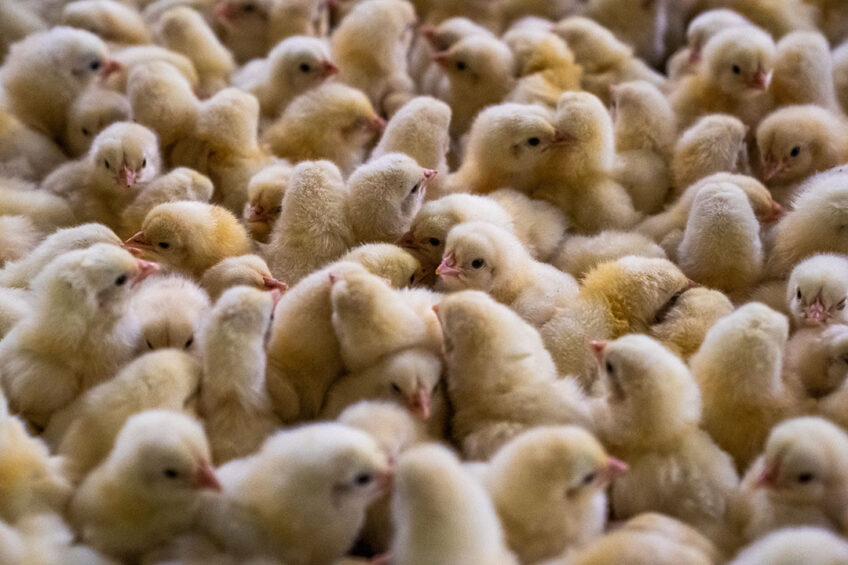Glycine alleviates heat stress-induced impairment in broilers

A study (published in the Poultry Science Journal) elaborates on ways that glycine alleviates heat stress-induced dysfunction of the antioxidant system and the intestinal barrier function in broilers.
Rising global temperatures present major challenges for the poultry industry. Due to their high metabolic rate and lack of sweat glands, chickens are more vulnerable to heat stress than mammals. In a high-temperature environment, the surface blood flow of poultry increases but the visceral blood flow decreases, leading to a reduction of oxygen flow to the intestinal mucosa and the production of reactive oxygen species (ROS), resulting in intestinal tight junction injury among other impairments.
Oxidative stress is the main factor in reducing growth performance under heat stress. Several functional nutrients with antioxidant effects are used to alleviate heat stress in poultry, including probiotics, amino acids, vitamins, trace elements, and electrolytes. The current study adds glycine to this list; glycine has important antioxidant, anti-inflammatory, cytoprotective and immunomodulatory properties. As chicks are unable to synthesize sufficient glycine to satisfy their requirements, this is an indispensable amino acid.
The study
In this study, a total of 300 1-day-old female broilers were randomly allocated to 5 treatments as follows:
Control: Broilers were kept under thermoneutral conditions and fed a basal diet.
Heat stress (HS): Broilers were fed a basal diet and reared at a high ambient temperature.
HS + Glycine (Gly): Broilers were fed a basal diet supplemented with either 0.5%, 1.0%, or 2.0% glycine and exposed to a high ambient temperature.
Performance
As expected, the growth performance of broilers exposed to high temperatures decreased significantly (Table 1). Feed intake (ADFI) and ADG were improved by the addition of all the glycine levels compared to the heat stress broilers. The decrease in growth performance corresponded with the impairment of the intestinal morphology and barrier function of broilers. However, the effect of supplementation with glycine showed no significant differences from both the control group and birds exposed to high temperatures.
Intestinal morphology
Alterations in the oxidative state of the intestine are usually accompanied by changes in intestinal morphology and permeability. Several studies have reported changes in intestinal morphology in poultry under heat stress conditions, including a decrease in villus height (VH) and villus to crypt depth ratio (V/C), and an increase in crypt depth. In the current study, the addition of glycine markedly increased the intestinal villus height (duodenum, jejunum, and ileum) and V/C (duodenum) in heat-stressed broilers. As dietary supplementation with glycine increased the VH and V/C ratio of the duodenum, villi damage of the jejunum and ileum was linearly alleviated.
Antioxidant system
Heat stress induces high production of ROS and disrupts the balance of antioxidant systems in the body. Exposure to heat stress led to oxidative damage with higher serum H2O2 and MDA compared to the control birds. After supplementation with glycine, both the MDA and H2O2contents decreased linearly. In line with these observations, glycine increased the activities of serum antioxidant enzymes superoxide dismutase (SOD), glutathione peroxidase (GPX) and the total antioxidant capacity (T-AOC) as well as catalase (CAT) and GPX activities in the ileum mucosa, while decreasing serum H2O2 and MDA levels (Table 2). Glycine is an important component of glutathione which consists of L-glutamic acid, L-cysteine, and glycine and is an important component of the body’s antioxidant system. Similar studies point to the same conclusion in rats, where studies show that dietary glycine prevents Kupffer cell activation, ameliorates oxidative stress, and reduces the impairment of the activities of the antioxidant enzymes SOD, GPX, and CAT.
Intestinal barrier function
The supplementation of glycine resulted in lower serum levels of LPS and upregulation of mRNA gene expression of the tight junction proteins Occludin and ZO-1 in ileal mucosa, indicating that glycine improves the intestinal barrier function in a dosage-dependent manner. On the other hand, the Keap1/Nrf2 pathway is one of the most important defence mechanisms against oxidation. It is involved in regulating the expression of downstream antioxidant-related genes such as NQO1, HO-1, GPX-1, and glutathione synthesis. In this study, researchers found that glycine increases the mRNA expression of Keap1 and NQO1 genes in the ileal mucosa. NQO1 is a flavin, an antioxidant enzyme, and an important antioxidant substance in the body. Under the catalysis of this enzyme, quinones are directly reduced to hydroquinone in vivo, reducing the oxygen radicals generated by quinone conversion, thus forming a protective mechanism against oxidative stress damage caused by the metabolism of quinones.
Ileal microbiota
The intestinal microbiota of poultry are complex and diverse, interacting with the host and external factors such as heat stress. Heat stress alters the relative abundance of caecal flora in broilers and hens, such as Firmicutes, Bacteroidetes, Tenericutes, and Proteobacteria. Previous studies report that dietary supplementation with 2% glycine decreases the number of pathogenic bacteria (Escherichia−Shigella, Clostridium, and Burkholderiales) and increases the number of short-chain fatty acid-producing bacteria (Blautia, Lachnospiraceae, Anaerostipes, and Prevotella) in the colon. In this study, heat stress decreased the α-diversity and β-diversity of ileal flora in broilers, changing the distribution of microorganisms at the phylum and genus levels. However, glycine did not affect the richness and diversity of ileal flora. The researchers concluded: “These results indicate that the microbial pathway may not be the main mechanism by which glycine alleviates heat stress in broilers.”
Conclusion
In summary, it was found that heat stress resulted in a breakdown in antioxidant capacity and intestinal function in broilers. “These effects on the antioxidant state and intestinal barrier were attenuated by glycine, suggesting that glycine might be a critical nutrient in maintaining intestinal barrier function and antioxidant capacity in heat-stressed broilers,” they concluded. The researchers also emphasised the need for further research to determine the optimal level of glycine required to alleviate heat stress in poultry.











